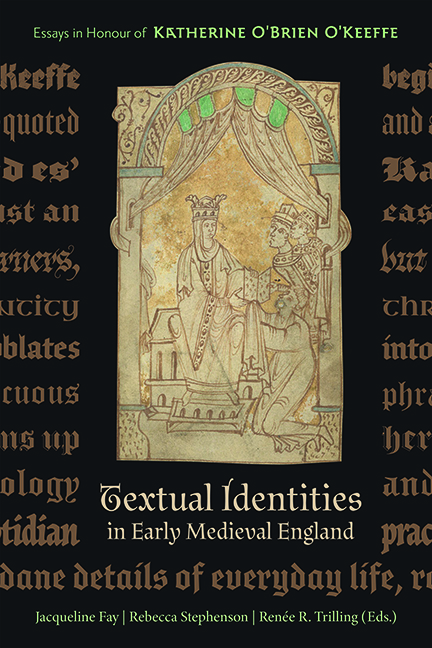Book contents
- Frontmatter
- Contents
- List of Illustrations
- List of Contributors
- Acknowledgments
- List of Abbreviations
- Introduction
- Part One Affect and Embodied Cognition in Medieval Didactic Texts
- Part Two Sovereignty, Power, and English Textual Identities
- Part Three Acts of Public Record in Making and Sustaining Communities
- Overview Of Career
- The Writings of Katherine O’Brien O’Keeffe
- Bibliography
- Index of Manuscripts
- General Index
- Tabula Gratulatoria
- Anglo-Saxon Studies
4 - Adam and Eve's Hands and Eyes: Covering the Face in the Junius Manuscript
Published online by Cambridge University Press: 26 May 2022
- Frontmatter
- Contents
- List of Illustrations
- List of Contributors
- Acknowledgments
- List of Abbreviations
- Introduction
- Part One Affect and Embodied Cognition in Medieval Didactic Texts
- Part Two Sovereignty, Power, and English Textual Identities
- Part Three Acts of Public Record in Making and Sustaining Communities
- Overview Of Career
- The Writings of Katherine O’Brien O’Keeffe
- Bibliography
- Index of Manuscripts
- General Index
- Tabula Gratulatoria
- Anglo-Saxon Studies
Summary
The significance of the face is not simply ‘in’ or ‘on’ the face, but a question of how we face the face, or how we are faced.
— Sara AhmedTHE POETIC account of Adam and Eve's Fall is punctuated in the Junius Manuscript with an abundance of illustrations. Four of these illustrations depict with apparent redundancy the fallen couple facing one another and uncannily holding their hands up to their faces, partially covering their eyes: in the upper frame of p. 34 (Figure 4.1), the couple cover their genitals with one hand and their faces with the other; in the lower frame, we see them surrounded by foliage, which has now provided a more substantial covering for their lower regions, though their hands still cover their faces; on p. 36 (Figure 4.2), they carry on with the same gesture, as the satanic messenger returns to hell; and on p. 39 (Figure 4.3), after looking at and conversing with one another, they take a seat and return their hands to their faces once again.
This sequence of gestures is an unusual variant in the iconography of Adam and Eve's shame, which is almost always characterized by the couple’s postlapsarian desire to conceal their newly sexualized bodies. While the Junius artist certainly conveys this more common gesture of concealment with the careful placement of the couple's hands and accompanying foliage (indicating their desire not to be seen), Adam and Eve's repeated and mutual act of covering their eyes (indicating, in contrast, a desire not to see) illuminates the artist's multivalent and dynamic interpretation of Adam and Eve's shame, the liability of vision, and what it means to be a human observer of evil, death, and suffering after the Fall.
The Junius Gestures
Of the possible Carolingian sources, none illustrates Adam and Eve with gestures identical to those in Junius 11. Several nearly contemporary illustrations come slightly closer, though none of these is identical either. For example, in the Old English Illustrated Hexateuch (c.1025–1050), Eve bows her face into her hand while attempting to hide from God, and in the lower frame on the same page Adam bows his head into his hand as God expels the couple from Eden (Figure 4.4).
- Type
- Chapter
- Information
- Textual Identities in Early Medieval EnglandEssays in Honour of Katherine O'Brien O'Keeffe, pp. 70 - 106Publisher: Boydell & BrewerPrint publication year: 2022

